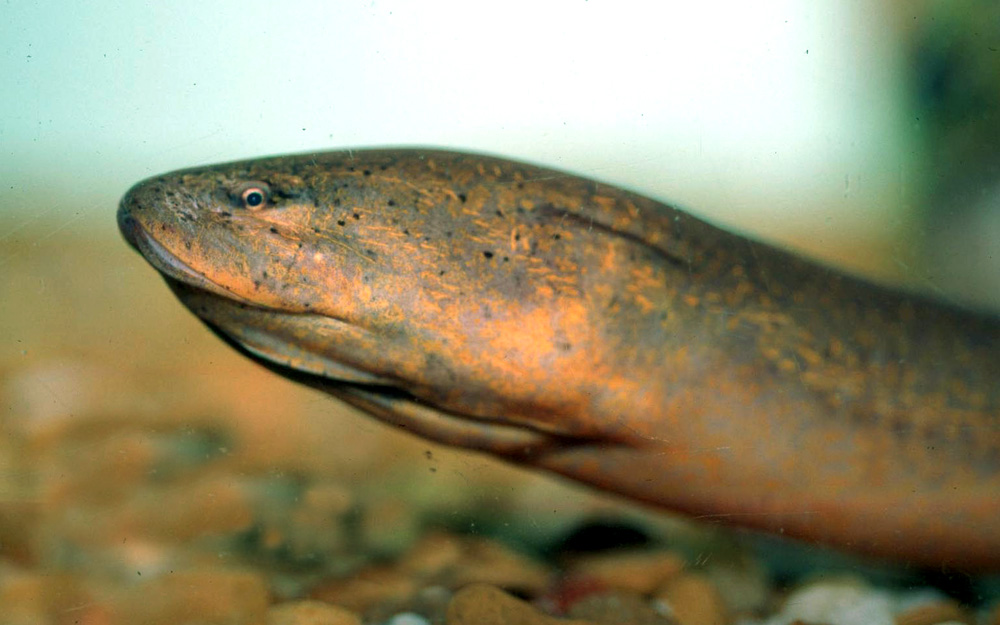Asian swamp eel
(Monopterus albus)

Classification
General data
The Asian swamp eel (Monopterus albus), also known as rice eel, ricefield eel, or rice paddy eel, is a commercially important, air-breathing species of fish in the family Synbranchidae. It occurs in East and Southeast Asia, where it is a very common foodstuff sold throughout the region. It has been introduced to two areas near the Everglades in Florida and near Atlanta in Georgia.
Description
The Asian swamp eel has a scaleless, anguilliform body that grows to a meter or less, typically 25 to 40 cm as an adult. As a swamp eel, it has a tapering tail and blunt snout, and lacks pectoral and pelvic fins. The dorsal, anal, and caudal fins are rudimentary, with the caudal fin often absent. These fins serve to protect the swamp eel against rolling, and assist in sudden turns and stops. Its gill membranes are fused, but one v-shaped gill is located beneath the head. Such a shape prevents reverse flow.
Their colour is variable, but generally olive or brown, with irregular dark flecks. Individuals in Florida usually have a dark body and head, with dark olive or brown dorsal coloring and light orange ventral coloring. Individuals caught in Florida can be more colourful, indicating breeding for the pet trade.
The mouth is large and protractile, and both upper and lower jaws have tiny teeth for eating fishes, worms, crustaceans, and other small aquatic animals.
Similar species
M. cuchia, a related species also commonly eaten, has also been introduced to the USA. When it breaths, the throat expands on sides of head, as opposed to ventrally in M. albus. This species also has suprapharyngeal air chambers, which M. albus does not, and a few scales, which are entirely absent in M. albus. M. cuchia has a single row of teeth, as opposed to two rows.
Distribution
It has a wide distribution. Monopterus albus is native to much of East and Southeast Asia, ranging west as far as India. M. albus is native to the tropical and subtropical areas of northern India and Burma to China, Japan, and Indo-Malayan Archipelago, possible populations in Far East Russia and northeastern Australia might belong to different cryptic species.
It is a common fish in India, southern China to Malaysia, and Indonesia.
The populations in most of Japan (Honshu and Kyushu) are likely introduced from China. The population in the Nara Basin was introduced from Korea in the beginning of the 20th century. Its distribution in Japan is discontinuous, which also indicates that it is introduced within the last millennium or so.
The eels found in Taiwan appear to belong to two different species, a Japanese form was introduced in 1940, but a Southeast Asian form is also common and may have also been introduced or be native.
The eels were first introduced to the Oahu in Hawaiian Islands around 1900, where they still occur.
Earliest record of the fish in the Philippines is in 1918 from a collection by the Commercial Museum of Philadelphia where it has become an invasive species.
Locations in the Southeastern United States were not colonized until the end of the 20th century. Around 1990, the eels were introduced to several ponds at a nature center near Atlanta, Georgia, within the Chattahoochee River drainage basin; by 1994, individuals had migrated to an adjacent marsh, the Chattahoochee Nature Center north of Atlanta.
Subsequently, eels were collected from Florida waters in 1997 at two widely separated areas, one in southeast and the other in west-central Florida. Tens of thousands of swamp eels are estimated to inhabit nearly 55 miles of two water canal systems in southern Florida, one in the North Miami area and another on the eastern side of Everglades National Park.
Two other populations of the eels have been discovered since 1993, one outside of Tampa, Florida, and one in southern Georgia near the Chattahoochee River. One or more of the populations are believed to be the result of an intentional or accidental release of the creature from a home aquarium or fish farm. Some populations may have been the result of an attempt by a few local residents to establish the eels as a food source.











